The Role of Knowledge Management in Decision Making and Education
VerifiedAdded on 2023/06/13
|11
|3074
|180
AI Summary
This article discusses the role of knowledge management in decision making and education, including the use of information technology and collaborative frameworks. It also critiques the implementation of knowledge management systems in organizations.
Contribute Materials
Your contribution can guide someone’s learning journey. Share your
documents today.
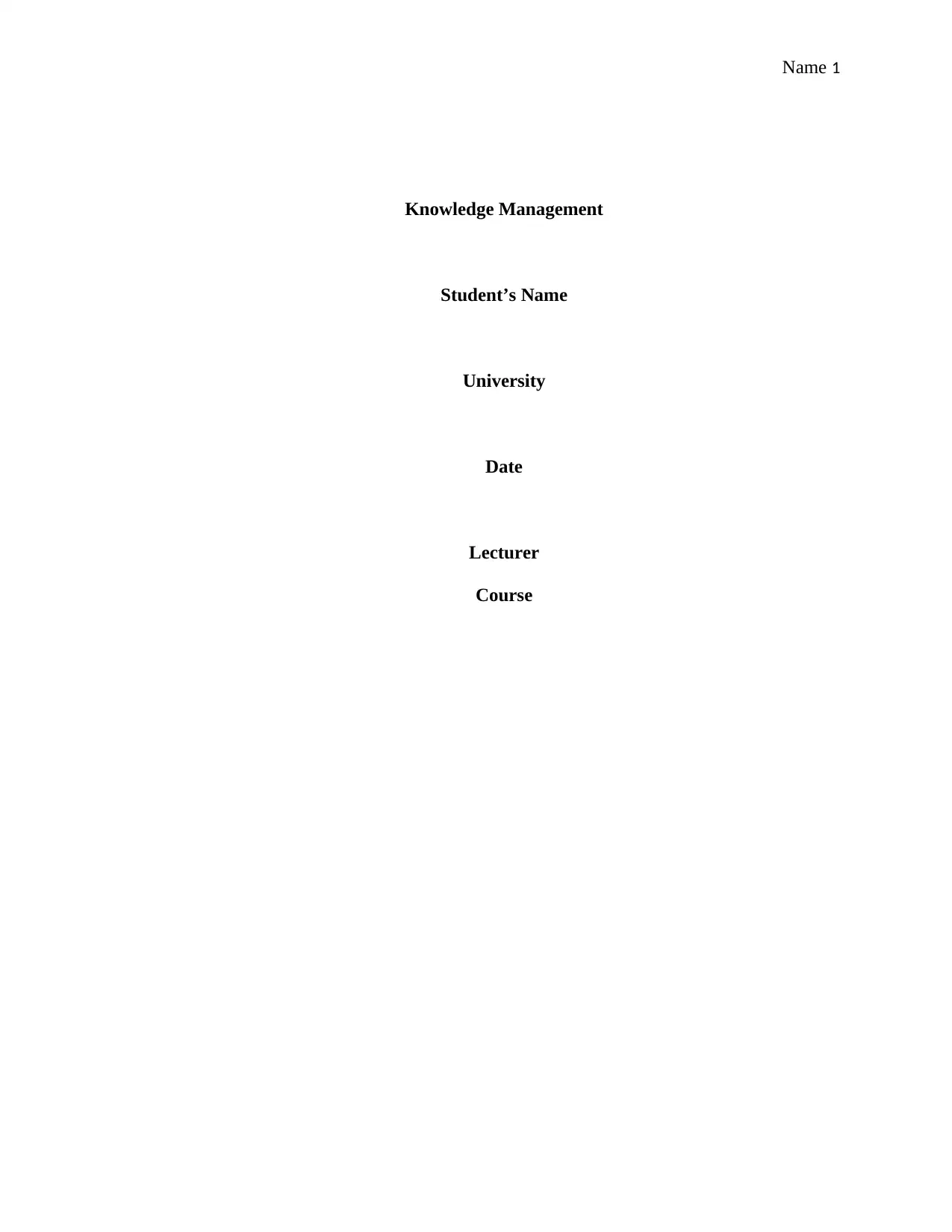
Name 1
Knowledge Management
Student’s Name
University
Date
Lecturer
Course
Knowledge Management
Student’s Name
University
Date
Lecturer
Course
Secure Best Marks with AI Grader
Need help grading? Try our AI Grader for instant feedback on your assignments.
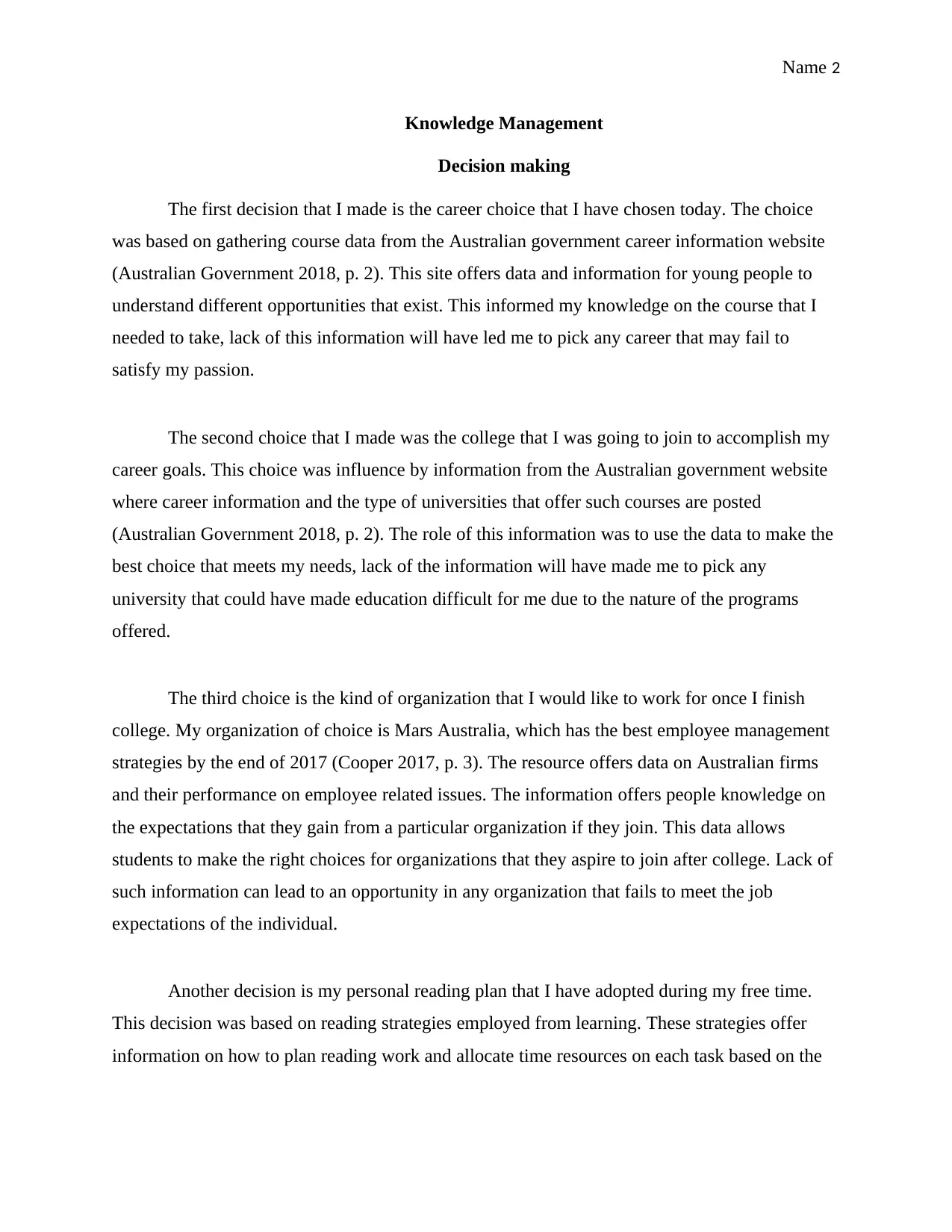
Name 2
Knowledge Management
Decision making
The first decision that I made is the career choice that I have chosen today. The choice
was based on gathering course data from the Australian government career information website
(Australian Government 2018, p. 2). This site offers data and information for young people to
understand different opportunities that exist. This informed my knowledge on the course that I
needed to take, lack of this information will have led me to pick any career that may fail to
satisfy my passion.
The second choice that I made was the college that I was going to join to accomplish my
career goals. This choice was influence by information from the Australian government website
where career information and the type of universities that offer such courses are posted
(Australian Government 2018, p. 2). The role of this information was to use the data to make the
best choice that meets my needs, lack of the information will have made me to pick any
university that could have made education difficult for me due to the nature of the programs
offered.
The third choice is the kind of organization that I would like to work for once I finish
college. My organization of choice is Mars Australia, which has the best employee management
strategies by the end of 2017 (Cooper 2017, p. 3). The resource offers data on Australian firms
and their performance on employee related issues. The information offers people knowledge on
the expectations that they gain from a particular organization if they join. This data allows
students to make the right choices for organizations that they aspire to join after college. Lack of
such information can lead to an opportunity in any organization that fails to meet the job
expectations of the individual.
Another decision is my personal reading plan that I have adopted during my free time.
This decision was based on reading strategies employed from learning. These strategies offer
information on how to plan reading work and allocate time resources on each task based on the
Knowledge Management
Decision making
The first decision that I made is the career choice that I have chosen today. The choice
was based on gathering course data from the Australian government career information website
(Australian Government 2018, p. 2). This site offers data and information for young people to
understand different opportunities that exist. This informed my knowledge on the course that I
needed to take, lack of this information will have led me to pick any career that may fail to
satisfy my passion.
The second choice that I made was the college that I was going to join to accomplish my
career goals. This choice was influence by information from the Australian government website
where career information and the type of universities that offer such courses are posted
(Australian Government 2018, p. 2). The role of this information was to use the data to make the
best choice that meets my needs, lack of the information will have made me to pick any
university that could have made education difficult for me due to the nature of the programs
offered.
The third choice is the kind of organization that I would like to work for once I finish
college. My organization of choice is Mars Australia, which has the best employee management
strategies by the end of 2017 (Cooper 2017, p. 3). The resource offers data on Australian firms
and their performance on employee related issues. The information offers people knowledge on
the expectations that they gain from a particular organization if they join. This data allows
students to make the right choices for organizations that they aspire to join after college. Lack of
such information can lead to an opportunity in any organization that fails to meet the job
expectations of the individual.
Another decision is my personal reading plan that I have adopted during my free time.
This decision was based on reading strategies employed from learning. These strategies offer
information on how to plan reading work and allocate time resources on each task based on the

Name 3
strength of each of them. The data collected here improves my planning ability through an
increased knowledge allocation of resources.
The last decision is the consideration I made last week when my friends asked me to go
out to the club at night with them. I chose not to attend the club because there had been reported
issues on violence and crime in clubs recently. The issues have been published on newspapers,
television and even social media on the dangers of hanging out in some areas. The data openly
exists on social media and other news channels to keep Australians informed on the current
crime rates in their localities. Lack of knowledge on information will have influenced the choice
that I make without considering the risky factors that relate to the existing trends in the locality.
Decision making is an integral element of life that human beings go through every day.
As humans facts carry more weight than instincts, thus when making decisions, people base on
the use of instincts to determine the choice that they make and how that choice meets their best
desire or leads to a better outcome. In the five decisions that I made above, knowledge through
data collection plays an important role in analyzing the outcome of each situation before
adopting one that meets all the conditions (McNamara, et al. 2009 p. 12). This reduces
ignorance, poor impulse control, and overconfidence which will all lead to poor decisions. Prior
information that I had about the situations informed the decision that I took since I could easily
make comparisons between the options that I had to determine the best decision that satisfies my
needs. Using data to make decisions reduces the use of instincts or impulse which are non-factual
feelings about a situation. In such cases, the pros and cons of each option are not weighed since
there are no gathered facts that can inform decision making.
Question two: Knowledge Management
Knowledge management is the process of collecting and processing inform to create,
disseminate and utilize the knowledge to fulfil organizational objectives. This process adds value
and increases productivity within the organization (Sroka & Cygler 2014, p. 629). Schools are
established on the basis of share knowledge where educators pass knowledge to learners through
a process of learning. Managing of such knowledge can increase learning outcomes that is
strength of each of them. The data collected here improves my planning ability through an
increased knowledge allocation of resources.
The last decision is the consideration I made last week when my friends asked me to go
out to the club at night with them. I chose not to attend the club because there had been reported
issues on violence and crime in clubs recently. The issues have been published on newspapers,
television and even social media on the dangers of hanging out in some areas. The data openly
exists on social media and other news channels to keep Australians informed on the current
crime rates in their localities. Lack of knowledge on information will have influenced the choice
that I make without considering the risky factors that relate to the existing trends in the locality.
Decision making is an integral element of life that human beings go through every day.
As humans facts carry more weight than instincts, thus when making decisions, people base on
the use of instincts to determine the choice that they make and how that choice meets their best
desire or leads to a better outcome. In the five decisions that I made above, knowledge through
data collection plays an important role in analyzing the outcome of each situation before
adopting one that meets all the conditions (McNamara, et al. 2009 p. 12). This reduces
ignorance, poor impulse control, and overconfidence which will all lead to poor decisions. Prior
information that I had about the situations informed the decision that I took since I could easily
make comparisons between the options that I had to determine the best decision that satisfies my
needs. Using data to make decisions reduces the use of instincts or impulse which are non-factual
feelings about a situation. In such cases, the pros and cons of each option are not weighed since
there are no gathered facts that can inform decision making.
Question two: Knowledge Management
Knowledge management is the process of collecting and processing inform to create,
disseminate and utilize the knowledge to fulfil organizational objectives. This process adds value
and increases productivity within the organization (Sroka & Cygler 2014, p. 629). Schools are
established on the basis of share knowledge where educators pass knowledge to learners through
a process of learning. Managing of such knowledge can increase learning outcomes that is

Name 4
measured through improved grades. Information technologies exist to make life easier and
improve the learning process by increasing access to information at all times (Cha et al. 2015, p.
4). Information technology is used to increase knowledge management through providing
adequate communication channels between teachers and students to discuss issues that affect
education, receive and review feedback from others and develop strategies for improving the
school based on the data (Zyngier 2010, p. 4). Such strategies allow data mining on student
scores and identify trends in performance teachers can identify strengths and weaknesses in the
student and develop strategies for addressing these challenges.
Most Australian schools have technology enriched environments that allow students to
achieve higher learning outcome. Thomson (2015, p.4) suggests that the Melbourne declaration
requires schools to enable ICT resources to learners as a way of increasing access to a wide
range of resources in the learning environment. James Ruse Agricultural High School is one of
the schools that have embraced the role of ICT in knowledge management (James Ruse
Agricultural High school 2017, p. 2). The school uses ICT to construct knowledge and add value
to learning through creating new ideas and products for learners. ICT is used in knowledge
management to improve the schools education philosophy of offering a dynamic curriculum that
meets the standards of the twenty first century through integration of ICT in learning processes.
The school uses the collaborative knowledge management framework through the
knowledge conversion process that allows collecting and sharing information between different
levels in the school. The process uses four models of socialization, externalization, combination
and internalization (Nonaka, et al. 2000, p. 11). This knowledge is created through a spiral
process that expands both horizontally and vertically across the school. Knowledge obtained is
shared via the school internet network where employees, teachers and management have their
own places of entering the system to sieve information. The system is designed in four layers of
data acquisition, data analysis, search layer, content analysis layer and user interface layer that
allow gathering and sharing information across the platform. The design of the system allows
combination of different components of the collaborative framework to group tasks with their
explanatory key words.
measured through improved grades. Information technologies exist to make life easier and
improve the learning process by increasing access to information at all times (Cha et al. 2015, p.
4). Information technology is used to increase knowledge management through providing
adequate communication channels between teachers and students to discuss issues that affect
education, receive and review feedback from others and develop strategies for improving the
school based on the data (Zyngier 2010, p. 4). Such strategies allow data mining on student
scores and identify trends in performance teachers can identify strengths and weaknesses in the
student and develop strategies for addressing these challenges.
Most Australian schools have technology enriched environments that allow students to
achieve higher learning outcome. Thomson (2015, p.4) suggests that the Melbourne declaration
requires schools to enable ICT resources to learners as a way of increasing access to a wide
range of resources in the learning environment. James Ruse Agricultural High School is one of
the schools that have embraced the role of ICT in knowledge management (James Ruse
Agricultural High school 2017, p. 2). The school uses ICT to construct knowledge and add value
to learning through creating new ideas and products for learners. ICT is used in knowledge
management to improve the schools education philosophy of offering a dynamic curriculum that
meets the standards of the twenty first century through integration of ICT in learning processes.
The school uses the collaborative knowledge management framework through the
knowledge conversion process that allows collecting and sharing information between different
levels in the school. The process uses four models of socialization, externalization, combination
and internalization (Nonaka, et al. 2000, p. 11). This knowledge is created through a spiral
process that expands both horizontally and vertically across the school. Knowledge obtained is
shared via the school internet network where employees, teachers and management have their
own places of entering the system to sieve information. The system is designed in four layers of
data acquisition, data analysis, search layer, content analysis layer and user interface layer that
allow gathering and sharing information across the platform. The design of the system allows
combination of different components of the collaborative framework to group tasks with their
explanatory key words.
Secure Best Marks with AI Grader
Need help grading? Try our AI Grader for instant feedback on your assignments.
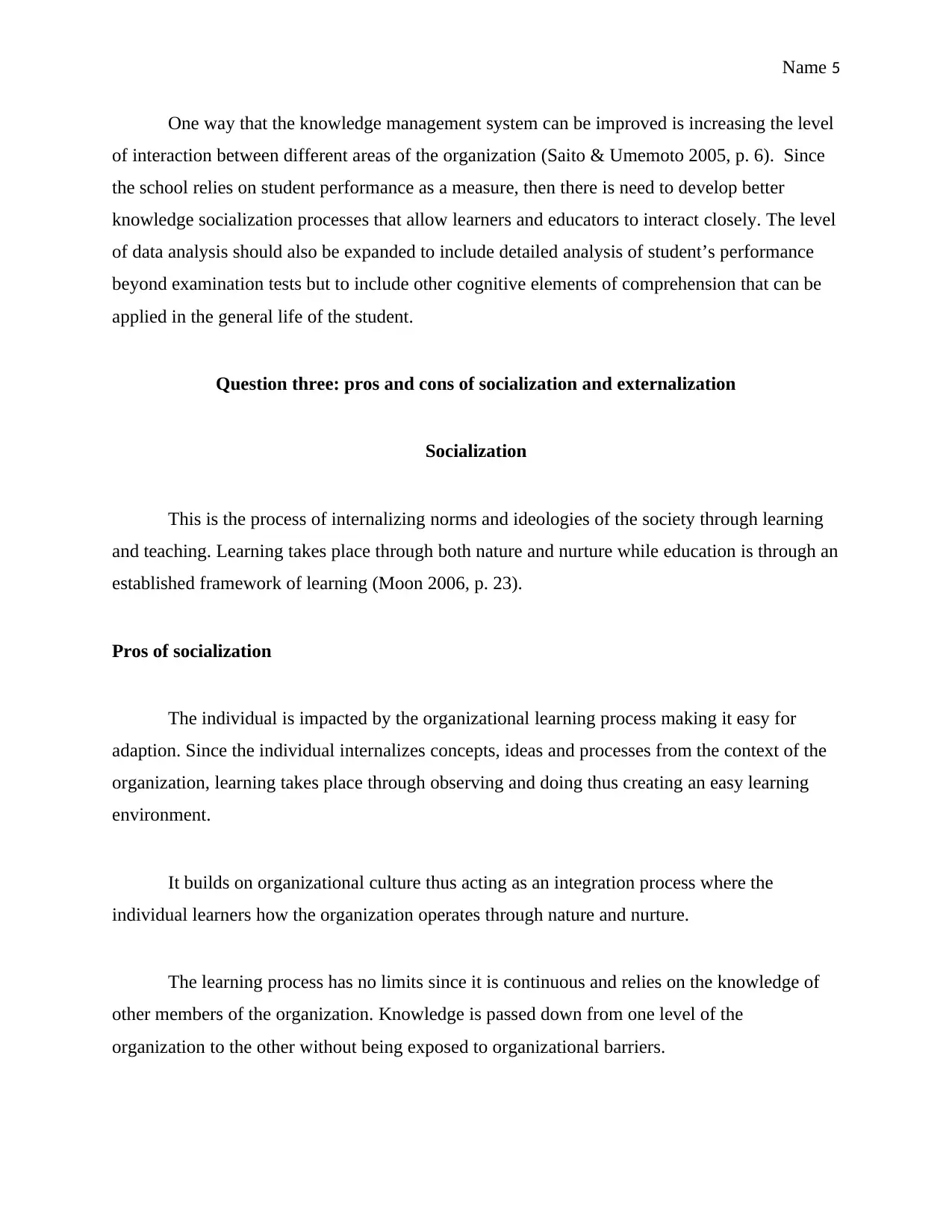
Name 5
One way that the knowledge management system can be improved is increasing the level
of interaction between different areas of the organization (Saito & Umemoto 2005, p. 6). Since
the school relies on student performance as a measure, then there is need to develop better
knowledge socialization processes that allow learners and educators to interact closely. The level
of data analysis should also be expanded to include detailed analysis of student’s performance
beyond examination tests but to include other cognitive elements of comprehension that can be
applied in the general life of the student.
Question three: pros and cons of socialization and externalization
Socialization
This is the process of internalizing norms and ideologies of the society through learning
and teaching. Learning takes place through both nature and nurture while education is through an
established framework of learning (Moon 2006, p. 23).
Pros of socialization
The individual is impacted by the organizational learning process making it easy for
adaption. Since the individual internalizes concepts, ideas and processes from the context of the
organization, learning takes place through observing and doing thus creating an easy learning
environment.
It builds on organizational culture thus acting as an integration process where the
individual learners how the organization operates through nature and nurture.
The learning process has no limits since it is continuous and relies on the knowledge of
other members of the organization. Knowledge is passed down from one level of the
organization to the other without being exposed to organizational barriers.
One way that the knowledge management system can be improved is increasing the level
of interaction between different areas of the organization (Saito & Umemoto 2005, p. 6). Since
the school relies on student performance as a measure, then there is need to develop better
knowledge socialization processes that allow learners and educators to interact closely. The level
of data analysis should also be expanded to include detailed analysis of student’s performance
beyond examination tests but to include other cognitive elements of comprehension that can be
applied in the general life of the student.
Question three: pros and cons of socialization and externalization
Socialization
This is the process of internalizing norms and ideologies of the society through learning
and teaching. Learning takes place through both nature and nurture while education is through an
established framework of learning (Moon 2006, p. 23).
Pros of socialization
The individual is impacted by the organizational learning process making it easy for
adaption. Since the individual internalizes concepts, ideas and processes from the context of the
organization, learning takes place through observing and doing thus creating an easy learning
environment.
It builds on organizational culture thus acting as an integration process where the
individual learners how the organization operates through nature and nurture.
The learning process has no limits since it is continuous and relies on the knowledge of
other members of the organization. Knowledge is passed down from one level of the
organization to the other without being exposed to organizational barriers.
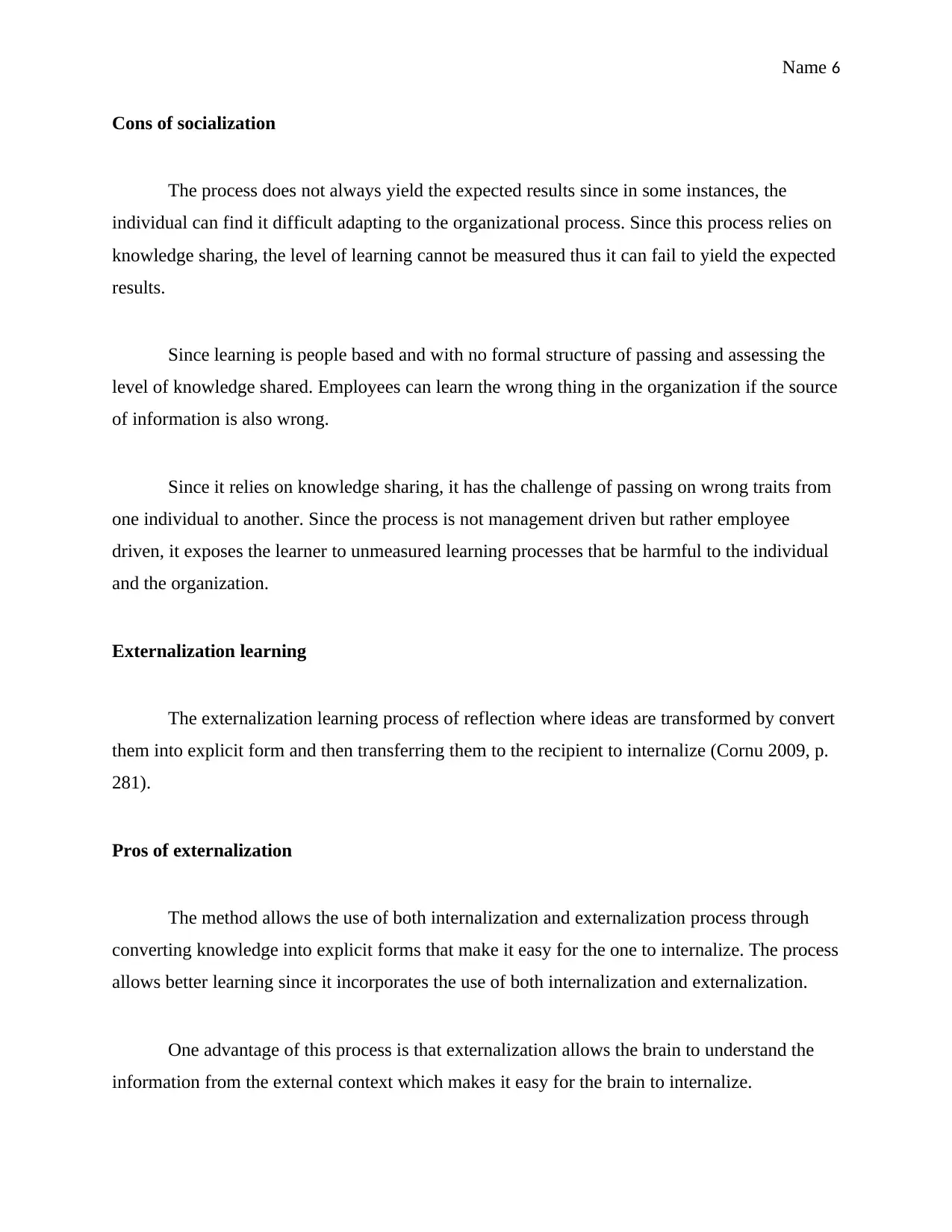
Name 6
Cons of socialization
The process does not always yield the expected results since in some instances, the
individual can find it difficult adapting to the organizational process. Since this process relies on
knowledge sharing, the level of learning cannot be measured thus it can fail to yield the expected
results.
Since learning is people based and with no formal structure of passing and assessing the
level of knowledge shared. Employees can learn the wrong thing in the organization if the source
of information is also wrong.
Since it relies on knowledge sharing, it has the challenge of passing on wrong traits from
one individual to another. Since the process is not management driven but rather employee
driven, it exposes the learner to unmeasured learning processes that be harmful to the individual
and the organization.
Externalization learning
The externalization learning process of reflection where ideas are transformed by convert
them into explicit form and then transferring them to the recipient to internalize (Cornu 2009, p.
281).
Pros of externalization
The method allows the use of both internalization and externalization process through
converting knowledge into explicit forms that make it easy for the one to internalize. The process
allows better learning since it incorporates the use of both internalization and externalization.
One advantage of this process is that externalization allows the brain to understand the
information from the external context which makes it easy for the brain to internalize.
Cons of socialization
The process does not always yield the expected results since in some instances, the
individual can find it difficult adapting to the organizational process. Since this process relies on
knowledge sharing, the level of learning cannot be measured thus it can fail to yield the expected
results.
Since learning is people based and with no formal structure of passing and assessing the
level of knowledge shared. Employees can learn the wrong thing in the organization if the source
of information is also wrong.
Since it relies on knowledge sharing, it has the challenge of passing on wrong traits from
one individual to another. Since the process is not management driven but rather employee
driven, it exposes the learner to unmeasured learning processes that be harmful to the individual
and the organization.
Externalization learning
The externalization learning process of reflection where ideas are transformed by convert
them into explicit form and then transferring them to the recipient to internalize (Cornu 2009, p.
281).
Pros of externalization
The method allows the use of both internalization and externalization process through
converting knowledge into explicit forms that make it easy for the one to internalize. The process
allows better learning since it incorporates the use of both internalization and externalization.
One advantage of this process is that externalization allows the brain to understand the
information from the external context which makes it easy for the brain to internalize.
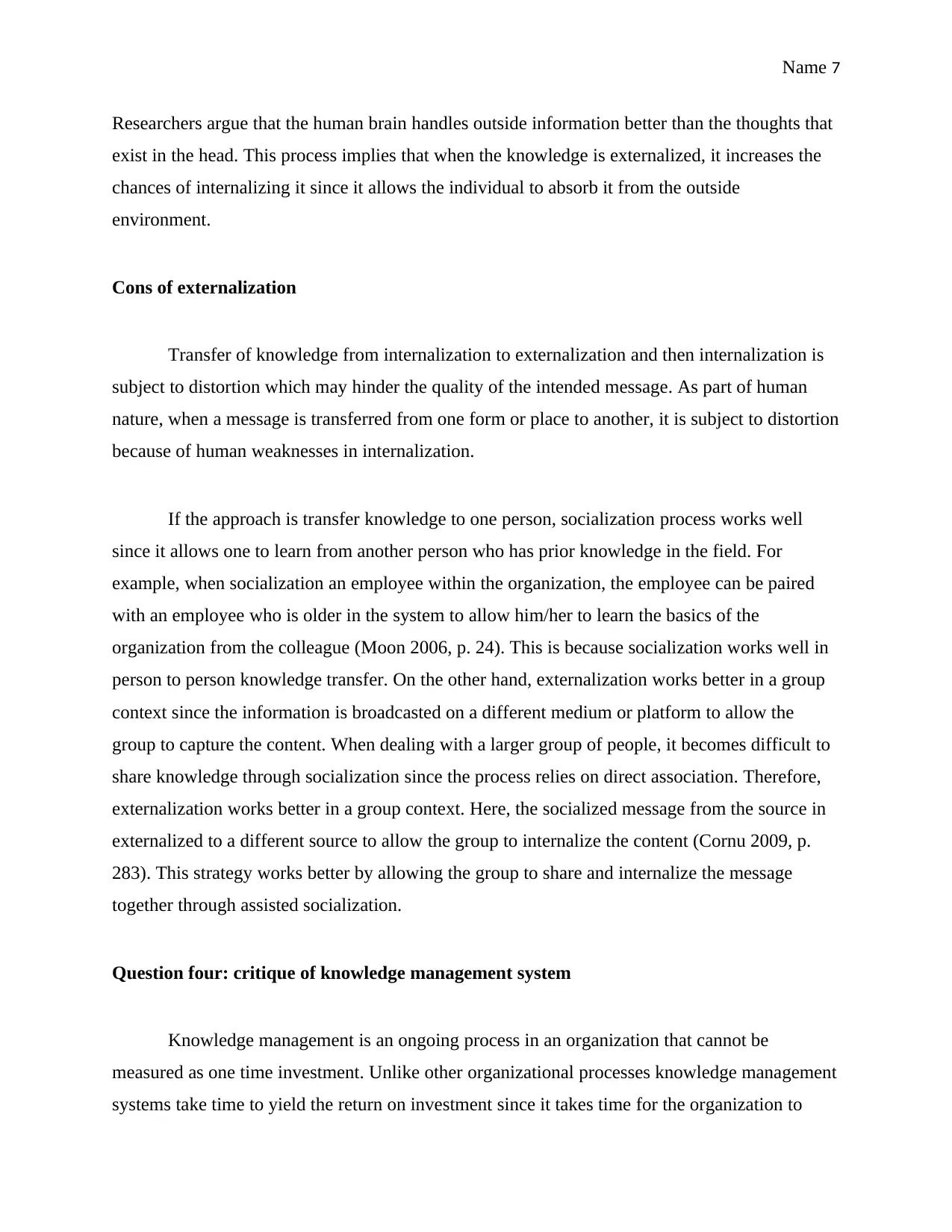
Name 7
Researchers argue that the human brain handles outside information better than the thoughts that
exist in the head. This process implies that when the knowledge is externalized, it increases the
chances of internalizing it since it allows the individual to absorb it from the outside
environment.
Cons of externalization
Transfer of knowledge from internalization to externalization and then internalization is
subject to distortion which may hinder the quality of the intended message. As part of human
nature, when a message is transferred from one form or place to another, it is subject to distortion
because of human weaknesses in internalization.
If the approach is transfer knowledge to one person, socialization process works well
since it allows one to learn from another person who has prior knowledge in the field. For
example, when socialization an employee within the organization, the employee can be paired
with an employee who is older in the system to allow him/her to learn the basics of the
organization from the colleague (Moon 2006, p. 24). This is because socialization works well in
person to person knowledge transfer. On the other hand, externalization works better in a group
context since the information is broadcasted on a different medium or platform to allow the
group to capture the content. When dealing with a larger group of people, it becomes difficult to
share knowledge through socialization since the process relies on direct association. Therefore,
externalization works better in a group context. Here, the socialized message from the source in
externalized to a different source to allow the group to internalize the content (Cornu 2009, p.
283). This strategy works better by allowing the group to share and internalize the message
together through assisted socialization.
Question four: critique of knowledge management system
Knowledge management is an ongoing process in an organization that cannot be
measured as one time investment. Unlike other organizational processes knowledge management
systems take time to yield the return on investment since it takes time for the organization to
Researchers argue that the human brain handles outside information better than the thoughts that
exist in the head. This process implies that when the knowledge is externalized, it increases the
chances of internalizing it since it allows the individual to absorb it from the outside
environment.
Cons of externalization
Transfer of knowledge from internalization to externalization and then internalization is
subject to distortion which may hinder the quality of the intended message. As part of human
nature, when a message is transferred from one form or place to another, it is subject to distortion
because of human weaknesses in internalization.
If the approach is transfer knowledge to one person, socialization process works well
since it allows one to learn from another person who has prior knowledge in the field. For
example, when socialization an employee within the organization, the employee can be paired
with an employee who is older in the system to allow him/her to learn the basics of the
organization from the colleague (Moon 2006, p. 24). This is because socialization works well in
person to person knowledge transfer. On the other hand, externalization works better in a group
context since the information is broadcasted on a different medium or platform to allow the
group to capture the content. When dealing with a larger group of people, it becomes difficult to
share knowledge through socialization since the process relies on direct association. Therefore,
externalization works better in a group context. Here, the socialized message from the source in
externalized to a different source to allow the group to internalize the content (Cornu 2009, p.
283). This strategy works better by allowing the group to share and internalize the message
together through assisted socialization.
Question four: critique of knowledge management system
Knowledge management is an ongoing process in an organization that cannot be
measured as one time investment. Unlike other organizational processes knowledge management
systems take time to yield the return on investment since it takes time for the organization to
Paraphrase This Document
Need a fresh take? Get an instant paraphrase of this document with our AI Paraphraser

Name 8
realize the benefits. Roch (2013) suggests that the fact that the process has been unsuccessful
does not mean that the process has failed. The organization has calculated the return on
investment using results from the first year of implementation which may not be accurate. Every
technology implemented in an organization takes time to absorb and diffuse a new system.
Technologies and new systems go through the process of adoption, adaption, absorption and
optimization. Depending on the structures that have been put in place during the introduction of
the new system, it takes different periods of time to yield the expected results.
The organization seems to be faced with the difficulty of putting the new system to work
effectively. Management is experiencing a higher distance between the technical promise and the
genuine achievement that was expected. Once a new system has been installed into the
organization, employees start the stages of technology diffusion (Botchkarev & Andru 2011, p.
251). Management needs to analyze the new system and determine the exact stage of diffusion
that the new system has reached. The highest level of optimization is what yields the expected
results since the new system will have completely diffused into the organization.
Instead of panicking and thinking of how to install the knowledge management system.
The organization needs to focus on optimizing the diffusion process to enable them calculate the
actual results for the stage of implementation that the system is. This process will give the exact
score that the company has realized. The cost of purchasing and implementing the software need
to be analyzed to determine the input from the organization (Coelho & Vilares 2010, p. 29).
Further, management has to analyze the savings that the system yields and use them to calculate
the average return on investment that the system yields for the company.
Therefore, the fact that the return on investment has not yielded the expected results does
not mean that the system is useless. The new system is undergoing the stages of technological
improvement that allow the technology to slowly diffuse into the organization and yield the
expected results. Management should rather develop strategies that will increase system
optimization and diffusion to allow the organization to reap the intended results (Leornard-
Barton & Kraus 2005, p. 5). The calculations should be clearly analyzed to ensure that they meet
all the requirements of calculating the impact of a system. Therefore, management should allow
realize the benefits. Roch (2013) suggests that the fact that the process has been unsuccessful
does not mean that the process has failed. The organization has calculated the return on
investment using results from the first year of implementation which may not be accurate. Every
technology implemented in an organization takes time to absorb and diffuse a new system.
Technologies and new systems go through the process of adoption, adaption, absorption and
optimization. Depending on the structures that have been put in place during the introduction of
the new system, it takes different periods of time to yield the expected results.
The organization seems to be faced with the difficulty of putting the new system to work
effectively. Management is experiencing a higher distance between the technical promise and the
genuine achievement that was expected. Once a new system has been installed into the
organization, employees start the stages of technology diffusion (Botchkarev & Andru 2011, p.
251). Management needs to analyze the new system and determine the exact stage of diffusion
that the new system has reached. The highest level of optimization is what yields the expected
results since the new system will have completely diffused into the organization.
Instead of panicking and thinking of how to install the knowledge management system.
The organization needs to focus on optimizing the diffusion process to enable them calculate the
actual results for the stage of implementation that the system is. This process will give the exact
score that the company has realized. The cost of purchasing and implementing the software need
to be analyzed to determine the input from the organization (Coelho & Vilares 2010, p. 29).
Further, management has to analyze the savings that the system yields and use them to calculate
the average return on investment that the system yields for the company.
Therefore, the fact that the return on investment has not yielded the expected results does
not mean that the system is useless. The new system is undergoing the stages of technological
improvement that allow the technology to slowly diffuse into the organization and yield the
expected results. Management should rather develop strategies that will increase system
optimization and diffusion to allow the organization to reap the intended results (Leornard-
Barton & Kraus 2005, p. 5). The calculations should be clearly analyzed to ensure that they meet
all the requirements of calculating the impact of a system. Therefore, management should allow

Name 9
the new knowledge management system time before drawing assumptions on the ineffectiveness
and its inability to yield the expected return on investment. Since return on investment is the
profitability ratio, management needs to consider other benefits that the system yields that cannot
be measured directly in the return on investment process.
the new knowledge management system time before drawing assumptions on the ineffectiveness
and its inability to yield the expected return on investment. Since return on investment is the
profitability ratio, management needs to consider other benefits that the system yields that cannot
be measured directly in the return on investment process.
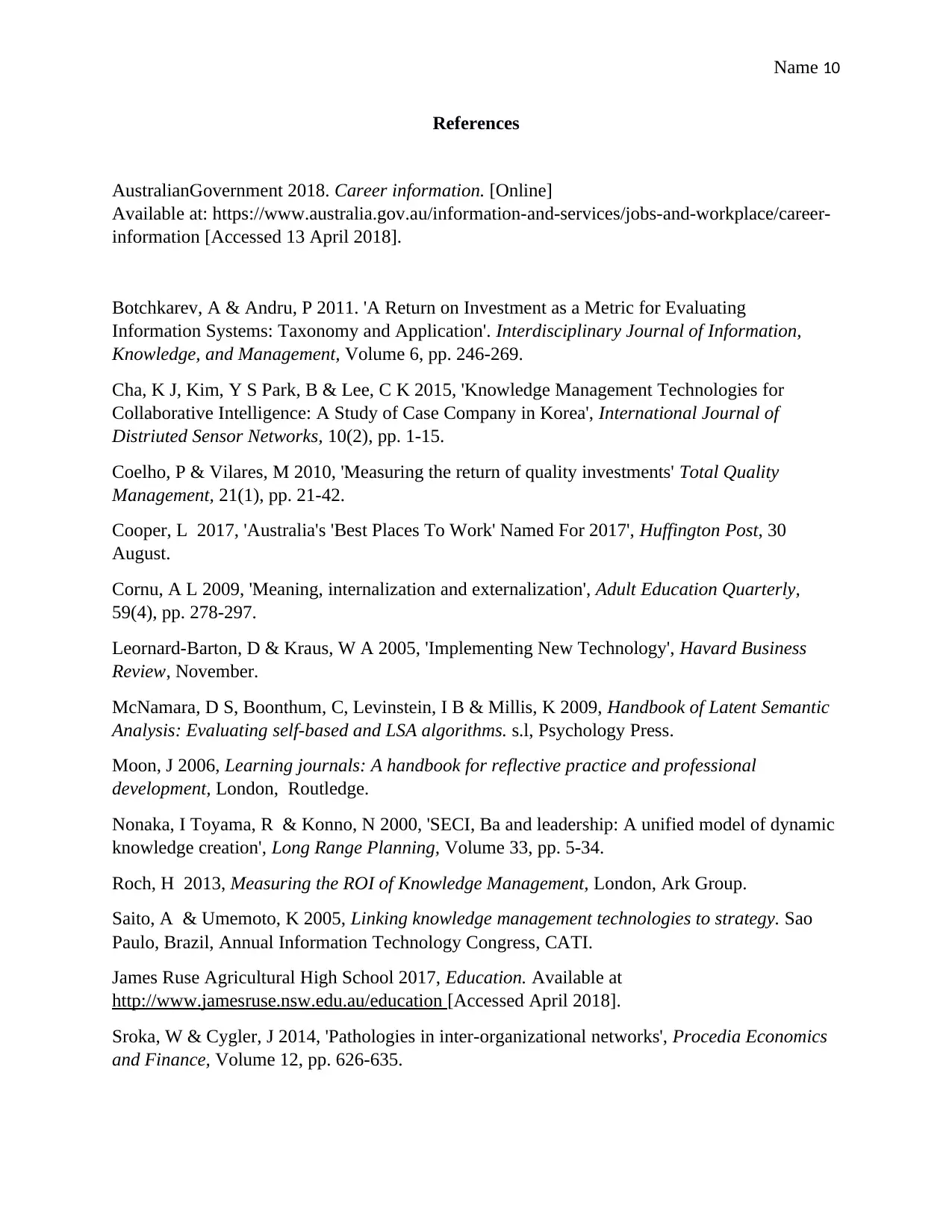
Name 10
References
AustralianGovernment 2018. Career information. [Online]
Available at: https://www.australia.gov.au/information-and-services/jobs-and-workplace/career-
information [Accessed 13 April 2018].
Botchkarev, A & Andru, P 2011. 'A Return on Investment as a Metric for Evaluating
Information Systems: Taxonomy and Application'. Interdisciplinary Journal of Information,
Knowledge, and Management, Volume 6, pp. 246-269.
Cha, K J, Kim, Y S Park, B & Lee, C K 2015, 'Knowledge Management Technologies for
Collaborative Intelligence: A Study of Case Company in Korea', International Journal of
Distriuted Sensor Networks, 10(2), pp. 1-15.
Coelho, P & Vilares, M 2010, 'Measuring the return of quality investments' Total Quality
Management, 21(1), pp. 21-42.
Cooper, L 2017, 'Australia's 'Best Places To Work' Named For 2017', Huffington Post, 30
August.
Cornu, A L 2009, 'Meaning, internalization and externalization', Adult Education Quarterly,
59(4), pp. 278-297.
Leornard-Barton, D & Kraus, W A 2005, 'Implementing New Technology', Havard Business
Review, November.
McNamara, D S, Boonthum, C, Levinstein, I B & Millis, K 2009, Handbook of Latent Semantic
Analysis: Evaluating self-based and LSA algorithms. s.l, Psychology Press.
Moon, J 2006, Learning journals: A handbook for reflective practice and professional
development, London, Routledge.
Nonaka, I Toyama, R & Konno, N 2000, 'SECI, Ba and leadership: A unified model of dynamic
knowledge creation', Long Range Planning, Volume 33, pp. 5-34.
Roch, H 2013, Measuring the ROI of Knowledge Management, London, Ark Group.
Saito, A & Umemoto, K 2005, Linking knowledge management technologies to strategy. Sao
Paulo, Brazil, Annual Information Technology Congress, CATI.
James Ruse Agricultural High School 2017, Education. Available at
http://www.jamesruse.nsw.edu.au/education [Accessed April 2018].
Sroka, W & Cygler, J 2014, 'Pathologies in inter-organizational networks', Procedia Economics
and Finance, Volume 12, pp. 626-635.
References
AustralianGovernment 2018. Career information. [Online]
Available at: https://www.australia.gov.au/information-and-services/jobs-and-workplace/career-
information [Accessed 13 April 2018].
Botchkarev, A & Andru, P 2011. 'A Return on Investment as a Metric for Evaluating
Information Systems: Taxonomy and Application'. Interdisciplinary Journal of Information,
Knowledge, and Management, Volume 6, pp. 246-269.
Cha, K J, Kim, Y S Park, B & Lee, C K 2015, 'Knowledge Management Technologies for
Collaborative Intelligence: A Study of Case Company in Korea', International Journal of
Distriuted Sensor Networks, 10(2), pp. 1-15.
Coelho, P & Vilares, M 2010, 'Measuring the return of quality investments' Total Quality
Management, 21(1), pp. 21-42.
Cooper, L 2017, 'Australia's 'Best Places To Work' Named For 2017', Huffington Post, 30
August.
Cornu, A L 2009, 'Meaning, internalization and externalization', Adult Education Quarterly,
59(4), pp. 278-297.
Leornard-Barton, D & Kraus, W A 2005, 'Implementing New Technology', Havard Business
Review, November.
McNamara, D S, Boonthum, C, Levinstein, I B & Millis, K 2009, Handbook of Latent Semantic
Analysis: Evaluating self-based and LSA algorithms. s.l, Psychology Press.
Moon, J 2006, Learning journals: A handbook for reflective practice and professional
development, London, Routledge.
Nonaka, I Toyama, R & Konno, N 2000, 'SECI, Ba and leadership: A unified model of dynamic
knowledge creation', Long Range Planning, Volume 33, pp. 5-34.
Roch, H 2013, Measuring the ROI of Knowledge Management, London, Ark Group.
Saito, A & Umemoto, K 2005, Linking knowledge management technologies to strategy. Sao
Paulo, Brazil, Annual Information Technology Congress, CATI.
James Ruse Agricultural High School 2017, Education. Available at
http://www.jamesruse.nsw.edu.au/education [Accessed April 2018].
Sroka, W & Cygler, J 2014, 'Pathologies in inter-organizational networks', Procedia Economics
and Finance, Volume 12, pp. 626-635.
Secure Best Marks with AI Grader
Need help grading? Try our AI Grader for instant feedback on your assignments.
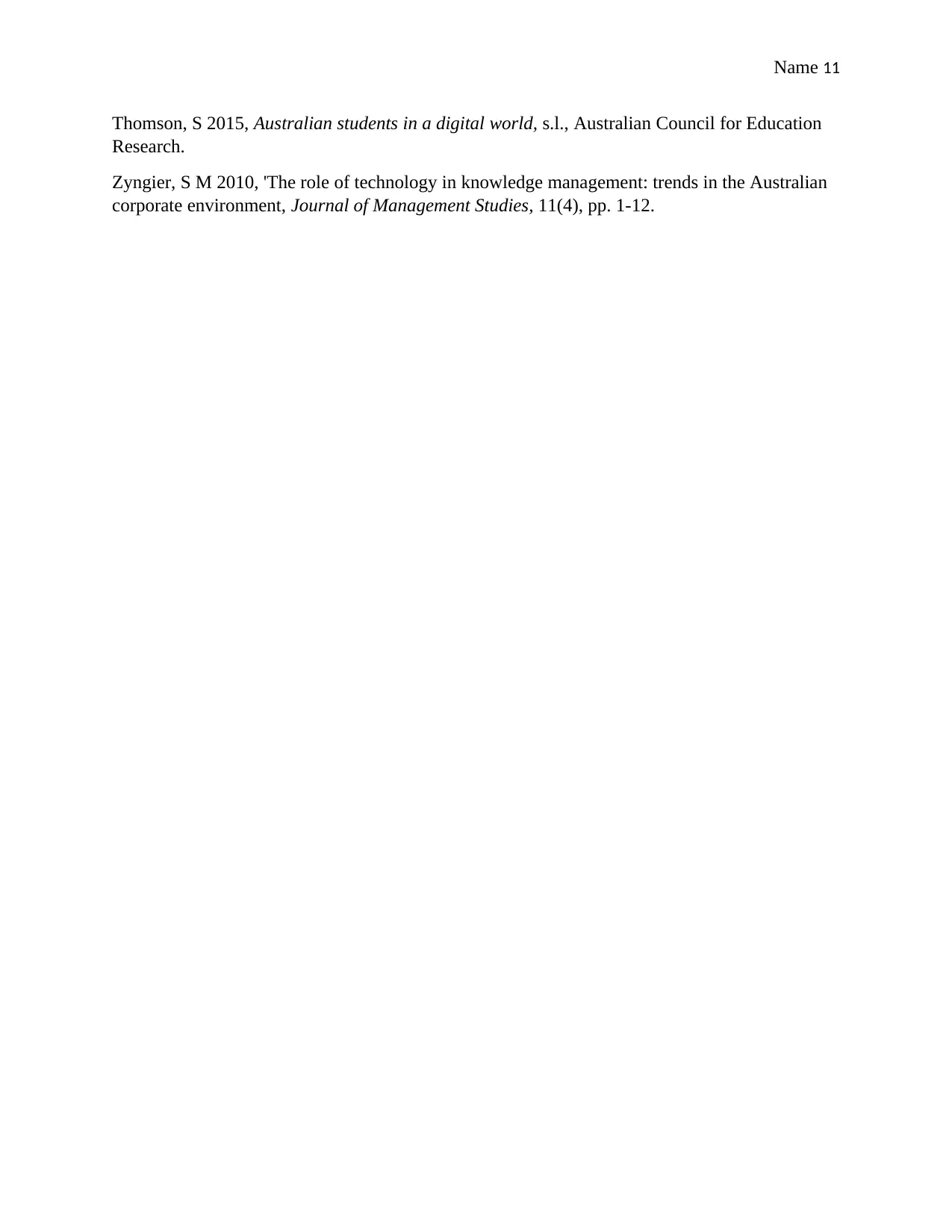
Name 11
Thomson, S 2015, Australian students in a digital world, s.l., Australian Council for Education
Research.
Zyngier, S M 2010, 'The role of technology in knowledge management: trends in the Australian
corporate environment, Journal of Management Studies, 11(4), pp. 1-12.
Thomson, S 2015, Australian students in a digital world, s.l., Australian Council for Education
Research.
Zyngier, S M 2010, 'The role of technology in knowledge management: trends in the Australian
corporate environment, Journal of Management Studies, 11(4), pp. 1-12.
1 out of 11
Related Documents
Your All-in-One AI-Powered Toolkit for Academic Success.
+13062052269
info@desklib.com
Available 24*7 on WhatsApp / Email
![[object Object]](/_next/static/media/star-bottom.7253800d.svg)
Unlock your academic potential
© 2024 | Zucol Services PVT LTD | All rights reserved.





